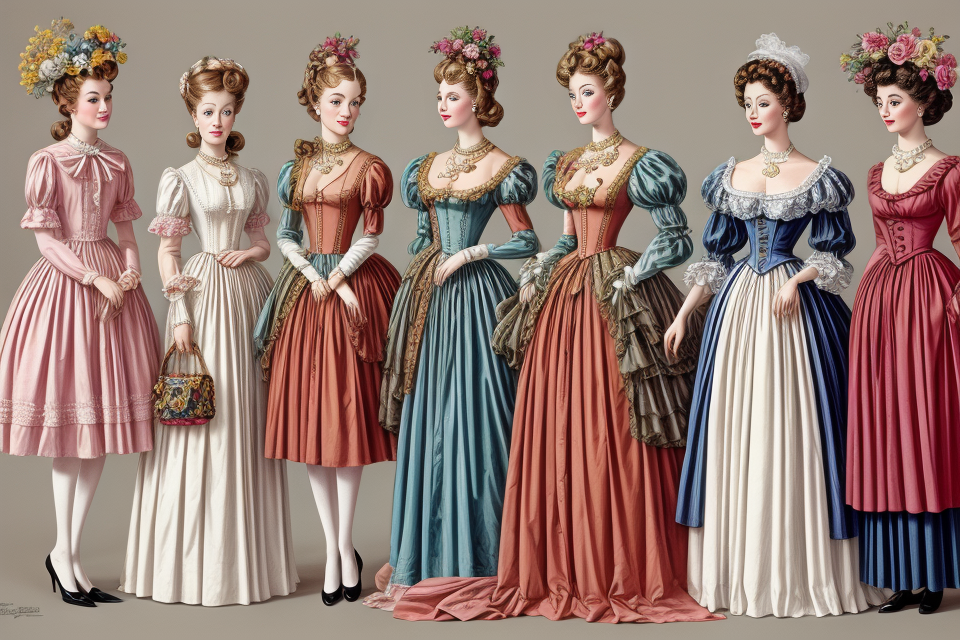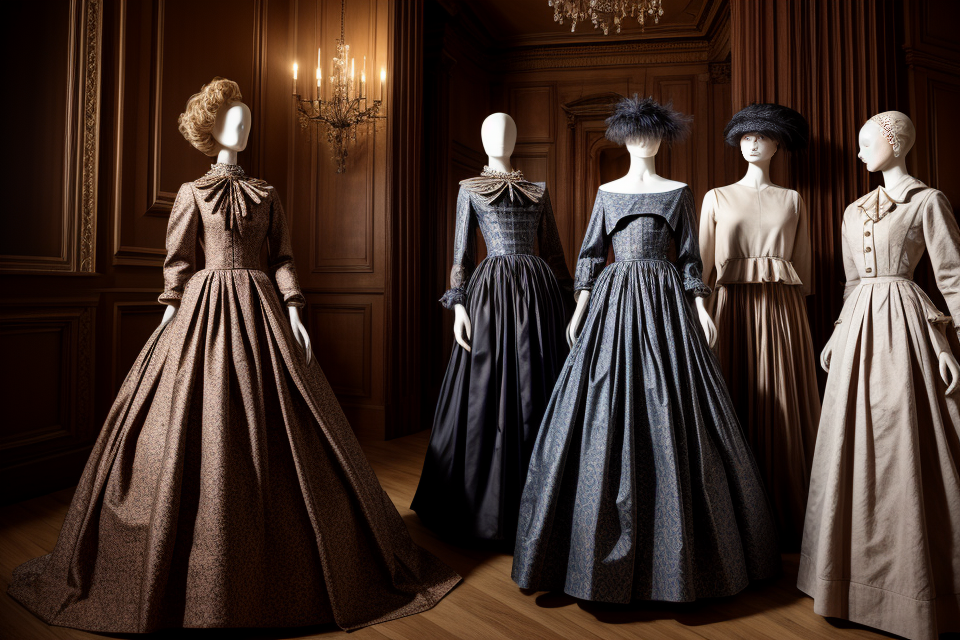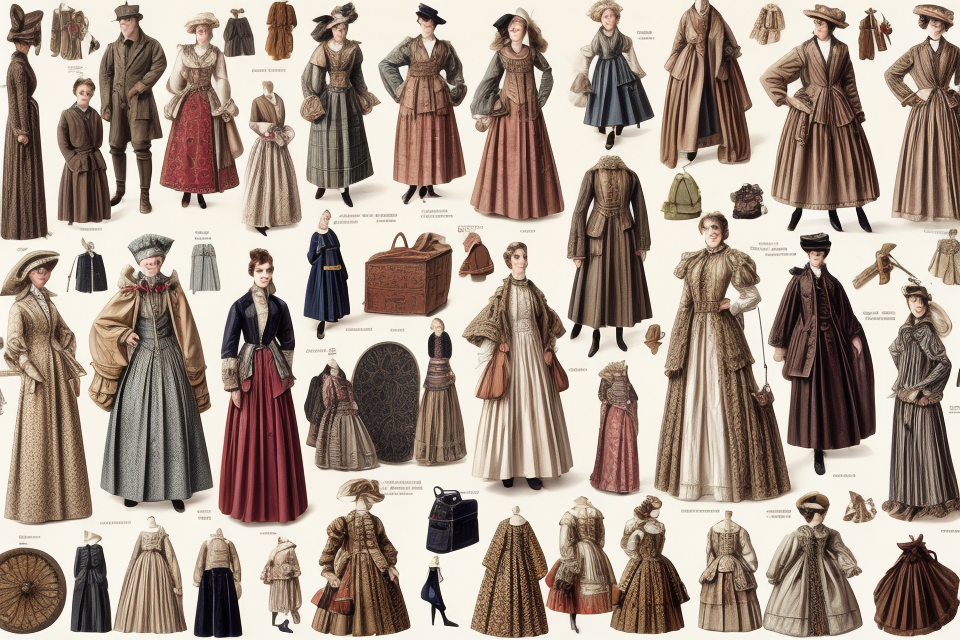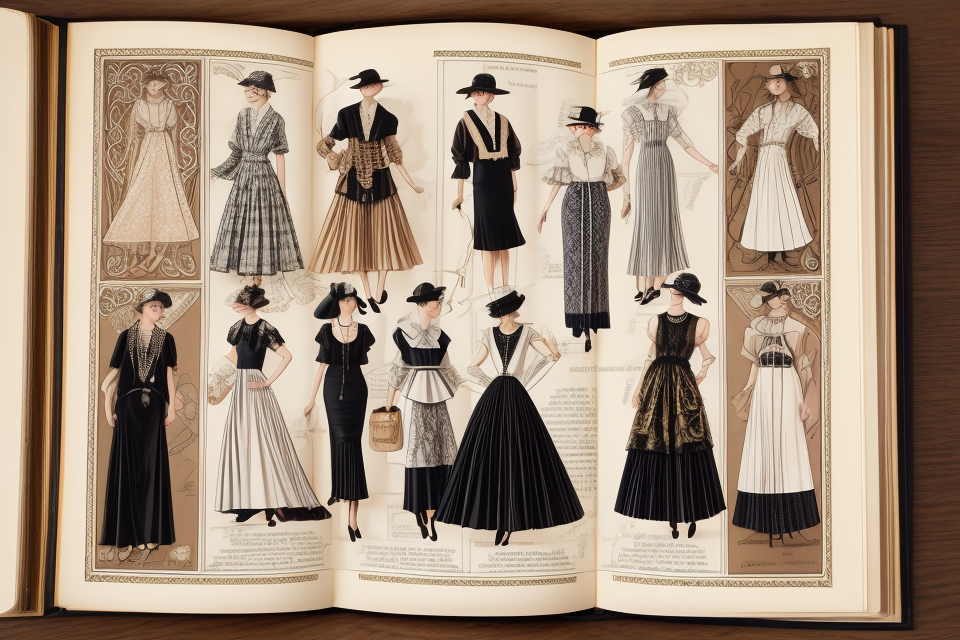
Fashion is not just about the clothes we wear, it’s a reflection of our history, culture, and identity. From the way we dress to the accessories we choose, fashion tells a story about who we are and where we come from. Throughout history, fashion has been influenced by significant events, social movements, and cultural shifts. This is evident in the way fashion has evolved over time, reflecting the changes in society and the world around us. In this article, we will explore how fashion represents our history and the impact it has had on our lives.
Fashion has always been a reflection of the historical era it belongs to. Every era has its own unique style, which reflects the social, political, and economic conditions of the time. For example, the flapper dresses and feather headbands of the Roaring Twenties represented the newfound freedom and carefree attitude of women during that time. Similarly, the mod styles of the 1960s represented the optimism and youth culture of the time. Through fashion, we can see how people of different eras expressed themselves and their values, and how they responded to the events and challenges of their time. Thus, fashion is not just a superficial aspect of our lives, but a powerful medium that reflects our history and culture.
The Role of Fashion in Preserving History
The Importance of Clothing as a Historical Document
Clothing has long been recognized as an important historical document, providing insights into the past that would otherwise be lost. The way people dressed, the materials they used, and the styles they followed all reflect the cultural, social, and economic conditions of their time.
Clothing as a Reflection of Culture and Society
Clothing is a reflection of the culture and society in which it was produced. Different cultures have their own unique styles, which are shaped by their history, geography, and traditions. For example, the traditional dress of a particular region may reflect its climate, the materials available, and the crafts and techniques that have been passed down through generations. By studying clothing, historians can gain a better understanding of the culture and society of the past.
Clothing as a Source of Information on Past Eras
Clothing is also a valuable source of information on past eras. The way people dressed can provide clues about their social status, occupation, and personal beliefs. For example, the clothing of the wealthy and the poor often differed significantly, reflecting the economic conditions of the time. Similarly, the clothing of different professions, such as soldiers or priests, had distinctive styles that helped to identify them. By studying clothing, historians can gain insights into the daily life and social structures of the past.
In addition to providing information about the past, clothing can also help to preserve it. Many historic garments and textiles have been carefully preserved in museums and archives, providing a tangible link to the past. By studying these objects, historians can learn more about the materials and techniques used to produce them, as well as the social and cultural context in which they were made.
Overall, the importance of clothing as a historical document cannot be overstated. It provides a unique window into the past, allowing us to better understand the culture, society, and daily life of previous eras.
The Preservation of Fashion Through the Ages
Fashion has been a vital component of human culture for centuries, and it has played a significant role in preserving history. The way people dressed and adorned themselves has been influenced by historical events, social norms, and cultural traditions. In this section, we will explore how fashion has been preserved through the ages and how it has served as a window into the past.
The Evolution of Fashion over Time
Fashion has evolved significantly over time, and the way people dressed in the past can provide valuable insights into the historical context of a particular era. For example, the clothing styles of the Elizabethan era were influenced by the social and political climate of the time, and they reflect the wealth and power of the ruling class. Similarly, the fashion of the 1920s was influenced by the social and economic changes brought about by World War I, and it reflected the newfound freedom and liberation of women.
The Influence of Historical Events on Fashion
Historical events have also had a significant impact on fashion, and the way people dressed during a particular era can provide insight into the social and political climate of the time. For example, the clothing styles of the 1960s were influenced by the counterculture movement and the anti-war protests, and they reflected a desire for change and a rejection of traditional values. Similarly, the fashion of the 1980s was influenced by the rise of consumer culture and the glamour of Hollywood, and it reflected a desire for material success and status.
Fashion has also been used as a form of protest and resistance throughout history. For example, during the French Revolution, people wore the tricolor cockade to show their support for the revolutionary movement, and it became a symbol of patriotism and resistance. Similarly, during the Civil Rights movement in the United States, people wore clothing and accessories to show their support for the cause, and they used fashion as a form of protest and resistance against racial discrimination.
In conclusion, fashion has played a significant role in preserving history, and it has served as a window into the past. The evolution of fashion over time and the influence of historical events on fashion provide valuable insights into the social and political context of a particular era. Fashion has also been used as a form of protest and resistance throughout history, and it has played a significant role in shaping cultural identity and expressing individuality.
The Relationship Between Fashion and Identity
Fashion as a Form of Self-Expression
Fashion has long been used as a form of self-expression, allowing individuals to communicate their personal style and identity to the world. Clothing has the power to convey a multitude of messages, from social status to cultural affiliation, and can serve as a means of self-expression and personal empowerment.
The Connection Between Clothing and Personal Identity
The clothing we wear can provide insight into our personal identity and values. For example, a person who values individuality and nonconformity may choose to wear unique, unconventional clothing, while someone who values tradition and conformity may opt for more traditional, conservative attire.
The Impact of Fashion on Social Identity
Fashion can also play a role in shaping our social identity, as it can be used to signal group membership and belonging. For instance, certain fashion choices may be associated with specific subcultures or social groups, such as punk or hip-hop, and wearing these styles can signal affiliation with those groups.
Additionally, fashion can be used to express solidarity with social or political movements. For example, wearing a t-shirt with a political slogan or a symbol of a particular cause can serve as a form of self-expression and show support for a particular movement.
Overall, fashion serves as a powerful tool for self-expression and can provide insight into an individual’s personal identity and values. Whether it’s through unique, unconventional clothing or signaling group membership and belonging, fashion has the ability to communicate a multitude of messages and play a significant role in shaping our identities.
The Use of Fashion to Communicate Cultural Identity
The Representation of Cultural Identity through Fashion
Fashion has long been used as a means of expressing cultural identity. This can be seen in the way that different cultures have their own unique styles of dress, which reflect their values, beliefs, and traditions. For example, the traditional clothing of the Maasai people of East Africa is distinctive and recognizable, with its bright colors and intricate beadwork. Similarly, the kimono is a Japanese garment that has been worn for centuries and is often associated with the country’s rich cultural heritage.
The Influence of Cultural Identity on Fashion
Fashion can also be influenced by cultural identity. For example, designers may draw inspiration from traditional clothing or textiles when creating new designs. This can help to preserve and celebrate cultural traditions, while also bringing them into the modern age. Additionally, fashion can be used to challenge stereotypes and promote diversity, by showcasing the beauty and richness of different cultures.
Fashion can be a powerful tool for communicating cultural identity. It can be used to express pride in one’s heritage, as well as to challenge stereotypes and promote understanding between different cultures. For example, the hijab is a piece of clothing that is worn by Muslim women as a symbol of their faith. It has been the subject of much debate and controversy in recent years, with some people using it as a symbol of oppression and others seeing it as a symbol of empowerment and resistance.
Additionally, fashion can be used to promote cross-cultural understanding and appreciation. For example, the popularity of traditional Japanese clothing, such as the kimono, has led to a renewed interest in the country’s cultural heritage. This has helped to promote a greater understanding and appreciation of Japanese culture, both within Japan and around the world.
Overall, fashion plays an important role in representing our history and culture. By expressing and celebrating our unique identities, we can promote understanding and appreciation of different cultures, while also preserving and promoting our own.
Fashion as a Reflection of Political and Economic Systems
The Influence of Political Systems on Fashion
The Relationship between Fashion and Power
Fashion has always been a reflection of the power dynamics in society. Throughout history, those in positions of power have used fashion as a way to assert their authority and maintain their status. For example, during the French Revolution, the ruling class abandoned their extravagant styles in favor of more demure clothing as a way to distance themselves from the aristocracy and align themselves with the revolutionaries. Similarly, during the reign of Napoleon Bonaparte, military-inspired fashion became popular as a way to celebrate the power and strength of the state.
The Use of Fashion as a Form of Propaganda
Fashion has also been used as a form of propaganda by political systems to promote their ideologies and values. During the Soviet era, for example, the government controlled the fashion industry and used it to promote communist ideals. Clothing was often mass-produced and standardized, with simple, utilitarian designs that reflected the values of the state. In Nazi Germany, the regime used fashion to promote its racial ideology, with clothing designed to emphasize Aryan physical characteristics and exclude those deemed racially inferior.
In addition to promoting political ideologies, fashion has also been used as a tool of diplomacy. In the 19th century, for example, the diplomatic corps in Paris became known for their elaborate and extravagant styles, which were used to demonstrate their country’s wealth and influence. Similarly, in the post-World War II era, American fashion designers like Christian Dior and Coco Chanel helped to promote American culture and values through their designs.
Overall, the influence of political systems on fashion cannot be overstated. Throughout history, those in power have used fashion as a way to assert their authority, promote their ideologies, and advance their interests. By understanding the complex relationship between fashion and politics, we can gain a deeper appreciation for the ways in which our history is reflected in the clothes we wear.
The Impact of Economic Systems on Fashion
The Relationship between Fashion and Economic Systems
The relationship between fashion and economic systems is complex and multifaceted. On one hand, economic systems can greatly influence the fashion industry, dictating the types of clothing that are produced, the materials used, and the prices at which they are sold. On the other hand, the fashion industry can also have a significant impact on economic systems, creating jobs, driving economic growth, and influencing consumer spending habits.
The Influence of Economic Systems on Fashion Trends
Economic systems can have a significant impact on fashion trends, as different economic conditions can lead to different consumer preferences and purchasing behaviors. For example, during times of economic hardship, consumers may be more likely to opt for more affordable, practical clothing items, such as classic denim jeans and simple t-shirts. In contrast, during times of economic prosperity, consumers may be more willing to invest in high-end fashion items, such as designer clothing and luxury accessories.
Additionally, economic systems can also influence the types of materials used in fashion production. For example, during times of high oil prices, fashion brands may be more likely to use alternative, eco-friendly materials, such as organic cotton and recycled polyester, in order to reduce their environmental impact and cut costs.
Overall, the relationship between fashion and economic systems is dynamic and ever-changing, with each influencing the other in complex and interconnected ways.
The Impact of Technology on Fashion
The Evolution of Fashion Technology
The Invention of the Sewing Machine
The invention of the sewing machine in the early 19th century revolutionized the fashion industry. Before this, clothing was primarily made by hand, which was a time-consuming and labor-intensive process. The sewing machine allowed for mass production of clothing, making it more affordable and accessible to the general population. This innovation also led to the creation of new fashion trends and styles, as designers could now produce clothing at a faster pace.
The Development of Synthetic Fabrics
The development of synthetic fabrics in the mid-20th century had a significant impact on the fashion industry. Synthetic fabrics such as nylon, polyester, and acrylic were created to replace natural fibers like silk and cotton. These fabrics were more durable, resistant to wrinkles, and less expensive to produce. This led to the mass production of clothing, which in turn made fashion more accessible to the masses. Synthetic fabrics also allowed for new styles and designs, as they could be easily molded into different shapes and forms.
The development of synthetic fabrics also had an impact on the environment. The production of synthetic fabrics requires large amounts of energy and chemicals, which can have negative effects on the environment. However, advancements in technology have led to the development of more sustainable synthetic fabrics, which are made from recycled materials or have a lower environmental impact.
The Influence of Technology on Fashion
The influence of technology on fashion cannot be overstated. The advancements in technology have had a profound impact on the fashion industry, from the way clothing is designed and produced to the way it is marketed and sold.
The Relationship between Fashion and Technology
Fashion and technology have always been intertwined, with new technologies driving innovation in the fashion industry. For example, the invention of the sewing machine in the 19th century revolutionized the way clothing was produced, making it possible to produce garments more quickly and at a lower cost. Similarly, the development of new materials and manufacturing techniques has allowed designers to create clothing that is lighter, stronger, and more comfortable than ever before.
The Impact of Technology on Fashion Trends
Technology has also had a significant impact on fashion trends. With the rise of social media, fashion trends can now spread rapidly across the globe, with influencers and celebrities sharing their favorite looks with millions of followers. This has led to a greater emphasis on streetwear and athleisure, as well as a greater focus on sustainability and ethical production.
In addition, technology has made it easier for designers to experiment with new styles and techniques, allowing them to create unique and innovative designs that push the boundaries of traditional fashion. This has led to a greater diversity of styles and a more inclusive approach to fashion, with designers catering to a wider range of body types and skin tones.
Overall, the influence of technology on fashion has been transformative, driving innovation and creativity while also challenging traditional norms and expectations. As technology continues to evolve, it is likely to have an even greater impact on the fashion industry, shaping the way we think about and express ourselves through clothing.
The Future of Fashion and History
The Preservation of Fashion for Future Generations
The Importance of Fashion Preservation
Fashion preservation is essential for several reasons. Firstly, it allows us to understand the cultural and social context of a particular era. Through fashion, we can gain insights into the values, beliefs, and attitudes of people from different time periods. For instance, the fashion choices of the 1960s reflected the countercultural movement and the desire for social change. Similarly, the fashion of the 1920s was influenced by the flapper culture and the rise of consumerism. By preserving fashion, we can keep these cultural contexts alive and help future generations understand the past.
Secondly, fashion preservation helps us to appreciate the art and craftsmanship involved in creating clothing. Many historical garments are works of art in themselves, with intricate details and embellishments that require skilled craftsmanship. By preserving these garments, we can appreciate the artistic and technical skills of the people who created them. Moreover, fashion preservation helps us to understand the evolution of fashion design and the influence of different designers and stylists on the industry.
The Challenges of Fashion Preservation
Despite its importance, fashion preservation faces several challenges. One of the main challenges is the cost of preserving and maintaining historical garments. Many museums and institutions struggle to find the resources to properly care for their fashion collections, which can be expensive to store and maintain. Additionally, fashion preservation requires specialized knowledge and expertise, which can be difficult to find.
Another challenge is the fragility of many historical garments. Many materials used in fashion, such as silk and lace, are delicate and prone to damage. Additionally, the chemicals used in the production of modern clothing can cause damage to historical garments, making their preservation even more difficult.
Despite these challenges, fashion preservation is essential for understanding our history and appreciating the art and craftsmanship involved in creating clothing. By working to overcome these challenges, we can ensure that future generations can appreciate and learn from our fashion history.
The Evolution of Fashion in the Future
As we move forward into the future, it is important to consider how fashion will continue to evolve and how it will represent our history. Here are some potential ways that fashion may change in the future:
The Influence of Emerging Technologies on Fashion
One of the most significant ways that fashion may change in the future is through the influence of emerging technologies. Advances in technology such as 3D printing, virtual reality, and artificial intelligence are already beginning to impact the fashion industry in various ways. For example, 3D printing is being used to create intricate and unique pieces, while virtual reality is being used to create immersive shopping experiences. As these technologies continue to develop, they will likely have an even greater impact on the fashion industry and the way that we create and consume fashion.
The Potential for New Fashion Trends in the Future
Another way that fashion may change in the future is through the potential for new fashion trends. As society continues to evolve and change, so too will the fashion industry. New trends will emerge that reflect the changing values and priorities of society. For example, there may be a greater focus on sustainability and ethical fashion, as consumers become more conscious of the environmental and social impact of their purchases. Alternatively, there may be a shift towards more functional and practical clothing, as people prioritize comfort and convenience in their wardrobes.
Overall, the future of fashion is likely to be shaped by a variety of factors, including emerging technologies, changing societal values, and global events. As we move forward, it will be interesting to see how fashion continues to evolve and how it will represent our history in the years to come.
FAQs
1. What is the relationship between fashion and history?
Fashion and history are closely related as fashion reflects the social, cultural, and political changes that occur throughout history. Fashion is a reflection of the values, beliefs, and attitudes of a particular time period, and it can be used to explore and understand historical events and movements.
2. How does fashion represent history?
Fashion represents history by reflecting the social, cultural, and political changes that occur throughout time. Fashion is a reflection of the values, beliefs, and attitudes of a particular time period, and it can be used to explore and understand historical events and movements. For example, the clothes worn during the Victorian era reflected the social and economic changes that occurred during that time, while the clothes worn during the 1960s reflected the social and political changes of that decade.
3. Can fashion be used to understand historical events and movements?
Yes, fashion can be used to understand historical events and movements. The clothes worn during a particular time period can provide insight into the social, cultural, and political changes that occurred during that time. For example, the clothes worn during the Victorian era reflected the social and economic changes that occurred during that time, while the clothes worn during the 1960s reflected the social and political changes of that decade.
4. How does fashion reflect cultural and social changes?
Fashion reflects cultural and social changes by reflecting the values, beliefs, and attitudes of a particular time period. The clothes worn during a particular time period can provide insight into the social and cultural changes that occurred during that time. For example, the clothes worn during the Victorian era reflected the social and economic changes that occurred during that time, while the clothes worn during the 1960s reflected the social and political changes of that decade.
5. How does fashion reflect political changes?
Fashion reflects political changes by reflecting the values, beliefs, and attitudes of a particular time period. The clothes worn during a particular time period can provide insight into the political changes that occurred during that time. For example, the clothes worn during the Victorian era reflected the social and economic changes that occurred during that time, while the clothes worn during the 1960s reflected the social and political changes of that decade.


